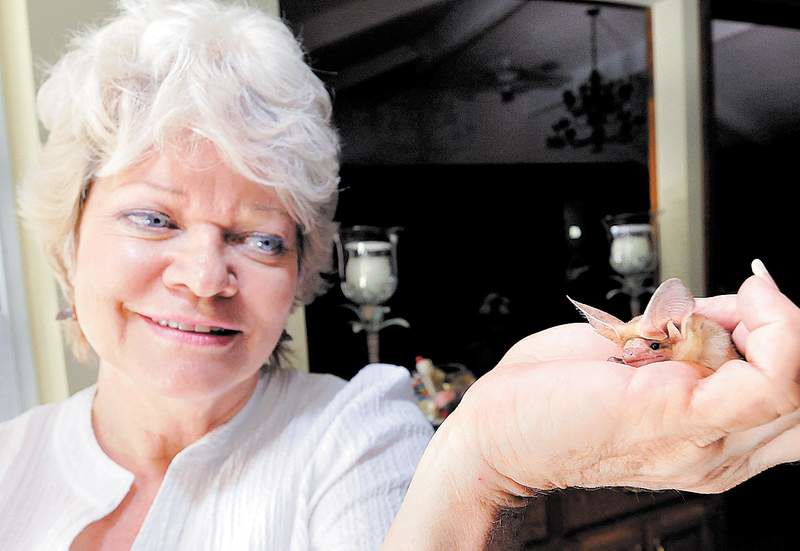Going to bat for their flying friends
Published 5:00 am Wednesday, September 15, 2010

- Dottie Hyatt, seen holding a Pallid bat last month in Keller, Texas, rescues and rehabilitates bats for Bat World Lone Star.
FORT WORTH, Texas — Dottie Hyatt has 36 bats living in her Keller, Texas, home, but she’s not calling an exterminator.
Hyatt is the one-woman bat rescue team of Bat World Lone Star, one of 20 satellite rescue centers around the country associated with the Bat World Sanctuary in Mineral Wells, Texas.
When an injured bat is discovered in North Texas, Hyatt’s home is often where it ends up. There, it is rehydrated, medicated, nurtured, given a name such as Alfie, Wilbur, Jolene or Cal, and hopefully returned to the great outdoors.
If the bat can’t live on its own, it becomes a permanent resident of Bat World Sanctuary.
A former IT project manager, Hyatt has been active in wildlife rescue most of her life, helping rehabilitate everything from bunnies to manatees. About 12 years ago at a workshop conducted by the International Wildlife Rehabilitation Council, she heard a lecture on bats.
“I learned that bats are clean, intelligent, affectionate and endangered,” said Hyatt. “My response was, ‘What?’ I was raised with all the same misconceptions as everyone else.”
Bats are beneficial
Bats are the subject of much misinformation.
Thanks to Hollywood, they have been the villains of scary movies, swooping in to attack victims or get tangled in their hair. Some people think bats are a type of rodent or bird. Others believe they carry a host of diseases, including the deadly rabies virus. All of these perceptions are false.
“Less than one-half of 1 percent of bats contract rabies,” said Hyatt. “They’re mammals just like us, and all mammals can contract rabies.”
In truth, bats are key players in a healthy environment.
They pollinate many plants, including mangoes, bananas and guavas. If you love margaritas, you should love bats, because they pollinate 98 percent of all agave plants, the source of tequila.
Their immense appetite for flying bugs helps control crop destroyers. Another bat delicacy is the mosquito, which can carry West Nile virus.
“The average bat gobbles 3,000 to 5,000 insects every night,” saidHyatt. “Bats save us billions — not millions — of dollars in crops each year.”
They’re also cute … and talkative
Despite the negative publicity they’ve received, bats are cute, Hyatt added. They purr when they’re happy and have almost no odor. They communicate when they are hungry or want attention, using squeaks and clicks in various tones to express their needs and opinions.
“Next to man, bats have the most complicated language there is,” she said.
Bats see well in the dark and have a unique echolocating system that allows them to emit high-frequency sound waves and then measure the echo that bounces back. This skill gives them a detailed mental picture of objects in their path and serves them well on dark nights.
Bats also have a metabolism that any dieter would envy.
The bat’s heart beats 900 to 1,300 times per minute when they are not hibernating, which means they process a meal in about 20 minutes and can be debilitated by disease in a few hours.
Someone who finds a sick bat must consider the situation an emergency.
“We have to get them sooner,” Hyatt said, speaking for all Bat World satellite centers. “If someone turns a bat into us two or three days after finding it, that bat is not going to survive.”
Giving an ailing bat to a wildlife rehabilitator can be a mistake, she added. Of the nation’s 5,000 certified wildlife rehabilitators, only 200 are bat specialists.
How you can help
• Stay out of caves and mines where bats are believed to hibernate.
• Minimize disturbance to natural bat habitats near your home by reducing outdoor lighting and curtailing tree clearing.
• Construct homes for bats (see www.batworld.org for free construction plans) and place them in appropriate areas. If you prefer to purchase a bat house, take the construction plans with you when you shop to ensure that you choose an appropriate structure.
• If bats are in your home and you don’t want them there, work with a local natural resource agency to remove them without harming them.
• Learn how to help a downed bat and be prepared to do so.
• Teach children to never touch ailing bats but to seek adult help immediately.






